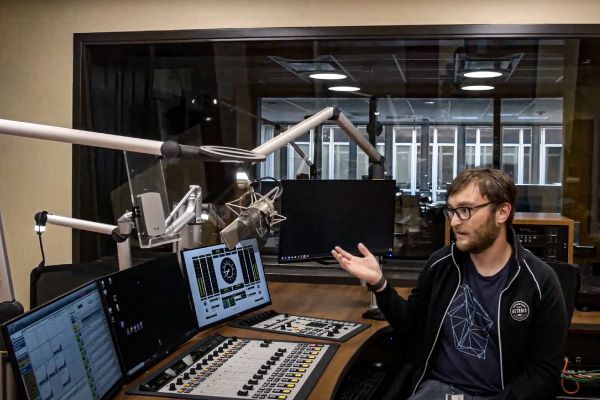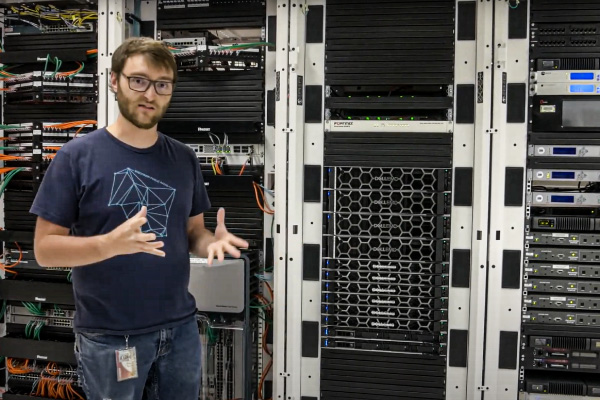With bragging rights as one of the oldest radio stations in the nation, Wisconsin Public Radio has proudly put content out over the airwaves for just over 100 years.
But from where she sits at the helm of WPR’s nerve center, Director of Engineering and Operations Britny Williams began to wonder if WPR was holding onto its storied senior status perhaps a bit too tightly.
Broadcasting out of Vilas Hall on the UW–Madison campus, WPR’s audio patch bays were still connected to its studios with the building’s original 1972 copper wiring. In addition to the “ancient” wiring, some critical gear in WPR’s Radio Operations Center equipment racks also dated back to Vilas’ construction almost 50 years ago.
“The most important one was the master audio switcher, made by a company that ceased to exist decades ago,” Williams explained. “It was basically like the brain of the whole place—it routed all audio all over, to studios, to bureaus, everywhere.”
“It was a single point of failure in our system for many years,” Williams emphasized. “And if it had died, there was nothing we could have done about it.”
That’s because unlike WPR, much of the radio broadcast industry had already gone digital, moving on from traditional analog signals and wiring. While other stations began using audio-over-IP (AoIP) systems to provide high-quality audio feeds over long distances with minimal delay, WPR was still cleaning corroded copper patch cables with steel wool, Williams explained.
“We were way behind the times here,” Williams said.
And as if that wasn’t enough of a mic drop, the old cigarette stains on the walls and original 1970s carpeting in the studios provided the perfect amplifier: WPR desperately needed an upgrade.
A complete transformation
Finally, in 2018, plans started to unfold.

In the beginning, Williams said, WPR focused first on just installing new consoles in the main studios, converting the big ones to audio-over-IP, and maybe throwing some new servers in the ROC racks—including replacing the volatile old master audio switcher.
But when plans evolved to build new equipment racks to address issues with the power system, the project screeched to a halt when a structural engineer determined that the floors of the 7th floor operations center just couldn’t hold that kind of weight.
“It turned out that this giant concrete building, Vilas Hall, wasn’t designed at all to handle the type of equipment we needed and still have a safe home,” Williams explained. “So, we panicked. We didn’t know what we were going to do.”
As WPR leaders scrambled to look for another location to build a data center on campus, Williams made a connection with the UW–Madison Division of Information Technology’s Data Center—just half a mile down University Avenue in the Computer Sciences building on W. Dayton Street.
From those initial conversations, a groundbreaking partnership was forged between WPR and DoIT, transforming how Wisconsin Public Radio brings content on the air and connects its seven statewide bureaus.
An ‘absolutely petrifying’ proposition
But while WPR and DoIT would eventually find that love was in the air(waves), they soon discovered that like most new relationships: it’s complicated.
When talks began in 2018, it was a radical concept for a radio station like WPR to place its operation center offsite from its main broadcasting studios, even less than a mile away.
“It was pretty unheard of,” Williams explained. “No one else had really taken the dive into doing something like this, let alone something of our size.”
Just thinking about WPR engineers being physically removed from their critical broadcasting equipment made Williams lose sleep.
“My first thought was, ‘Oh my God—we can’t do that!’” Williams recalls. “We just couldn’t put our precious radio racks in someone else’s building. The thought was absolutely petrifying to us.”
And it was an unprecedented proposition on DoIT’s side of the table, too.
The unrestricted, 24/7 access WPR needed went far beyond DoIT’s traditional “co-location” data center hosting services model, in which campus partners can essentially rent space for servers and other computing hardware—but under DoIT operation and administration in its secure Data Center.
“I’d say we both came to the table with a healthy skepticism,” says DoIT Data Center Services Manager Nate Royko Maurer, who also serves as DoIT’s assistant director of Systems Engineering & Operations.
“But ultimately, over the course of the next seven months, we were able to work through some thorny issues together and come up with innovations that significantly impacted the quality of their operations,” Royko Maurer added.
What is a data center?

Inside the whirring DoIT Data Center in the basement of the Computer Sciences building, row after row of equipment racks comprise the nerve system for UW–Madison’s information technology infrastructure. IT equipment housed in DoIT’s data centers support a variety of critical applications, data and services across campus, within the UW System, and beyond—from security cameras here in Madison to the BOREAS research network that connects UW–Madison with Iowa State, the University of Iowa and the University of Minnesota.
“Basically, data centers are large rooms with lots of power, cooling and network connectivity,” explains Chris Lund, a DoIT engineer who co-led the WPR project with fellow engineer Mark Misko.
Within each of the Data Center’s nearly floor-to-ceiling racks, you’ll find stacks of routers, switches, firewalls, storage systems, servers, application-delivery controllers and other IT infrastructure components. Snaking through the blinking, humming stacks of hardware, intricate bundles of wiring, fiber optic and network cables send data wherever it needs to go, powering key services like My UW-Madison, Bucky Backup, Learn@UW and many more.
“We have lots and lots of batteries, because this place can never shut down,” Lund explains while leading a tour of the critical IT hub. In the event of a utility power failure, generators and uninterruptible power supplies provide backup.
‘A complete game-changer’
For WPR, which formally became a part of UW–Madison in July 2018 with the restructuring of UW-Extension, taking advantage of DoIT infrastructure and partnering with UW–Madison’s central IT services began making more and more sense as discussions with DoIT continued, Williams says.
“I often refer to them now as our new best friends—it’s been amazing,” Williams said. “Every crazy idea we had, they always found a solution.”
Even after WPR’s successful digital switchover last year, DoIT is continuing to help WPR blaze new trails by exploring tapping into UW SysNet to connect its 7 statewide bureaus, which broadcast on 37 stations.
“It’s a massive project because we’re really big,” Williams says. “We’ve got a lot of people in the field and a lot of stations that ultimately need to get this audio. So the SysNet connection would be a complete game-changer in the way that we can operate.”
In a radio broadcasting industry that typically lags behind technical trends, Williams says it’s an exciting prospect to take new leaps forward with DoIT’s partnership.
“Nothing has fundamentally changed the future of Wisconsin Public Radio more,” added Williams. “I love the possibilities.”
Take a tour of the revamped Wisconsin Public Radio studios and Radio Operations Center with WPR Broadcast Engineer Eric Bartos:
